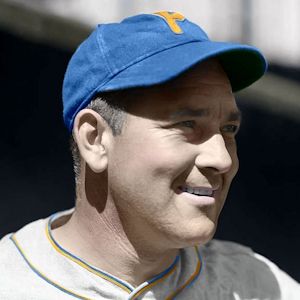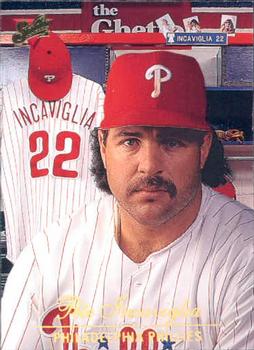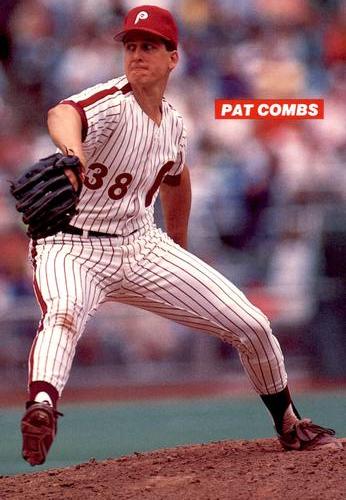Randy Lerch might be the only pitcher in baseball history to hit a home run in the top of the first inning and record just a single out before being taken out of the game in the bottom of the first inning.
Lerch, today's former Phillie of the Day, was selected by the Phillies in the eighth round of the 1973 draft. He was a tall, thin, lefthanded pitcher who had success in the minors before joining the Phillies starting rotation in 1977. I guess you could say he was effectively wild in his rookie season, because he won 10 games. But 22-year-old Lerch had a 5.07 ERA and gave up 207 hits and 78 walks in 168.2 innings.
His control improved in 1978 and his ERA dropped by more than a run. He pitched 184 innings and allowed 183 hits and 73 walks. In 1979, he pitched more innings, walked fewer guys, and saw his ERA drop again. But Lerch's ERA took a big hit on
May 17, 1979.
The wind was blowing out from the south that day, and when the wind blows out at Wrigley Field, runs come in bunches. And did they ever. The Phillies had their hitting shoes on in the first inning. Bake McBride led the game off with a single to left and Larry Bowa followed with a double to left, with McBride stopping at third. Pete Rose grounded back to pitcher Dennis Lamp, and McBride was out at home.
Then the fun really started. Mike Schmidt crushed a 3-run homer to left, and Del Unser and Garry Maddox each singled. Up came Bob Boone, who hit the second 3-run homer of the inning, giving the Phils a 6-0 lead. Dennis Lamp's day was done, recording just one out. Reliever Donnie Moore caught Rudy Meoli looking for the second out, and then Lerch, launched a home run into the first row of the left field bleachers, putting the Phils up 7-0. McBride popped out to third to end the inning.
So fresh off his home run and staked to a 7-0 lead, Lerch gave up single to the first three Cubs hitters–Ivan DeJesus, Mike Vail, and Bill Buckner. Bucker's hit scored DeJesus, making it 7-1. Dave "Kong" Kingman was next, and he hit an absolute moon shot of a home run that landed somewhere in Wisconsin. The Phils lead was down to 7-4. Lerch got Steve Ontiveros to ground out for the first out, but Jerry Martin followed with a double. Lerch's day was done. He fared slightly better than Lamp, allowing 5 runs. Doug Bird came in and got Barry Foote to line out to right. Ted Sizemore singled, scoring Martin and closing the book on Lerch. Moore, the reliever, followed with a triple to score Sizemore, making it 7-6. DeJesus flied out to right to end the inning. Whew. Lerch's ERA rose from 3.19 to 4.00 after that inning.
Things calmed down in the second as both teams failed to score. In the third, Maddox doubled and then Boone singled him home. Meoli flied out, Bird walked, and McBride singled, plating Boone. Bowa singled to load the bases and Pete Rose drove in 2 more runs making the score 11-6. Exit Moore, enter Willie Hernandez, who intentionally walked Schmidt. Unser hit into a fielders choice and Bowa scored. Maddox followed with the the third 3-run homer of the day for the Phils, pushing the lead to 15-6. Boone was hit by a pitch, Meoli singled, and then Bird struck out to end the inning.
The Cubs went quietly in their half of the third, and the Phils added 2 more runs in the 4th, giving them a 17-6 lead. Kingman and Ontiveros hit back-to-back homers in the bottom of the 4th, cutting the Phils lead to 17-9.
The Phils scored 4 more runs in the 5th to take a 21-9 lead. But then the Cubs struck back. They scored 7 runs off Tug McGraw, including homers from Buckner and Martin, making it 21-16. The Phils were blanked in the 6th, and the Cubs drew even closer, scoring on 2 groundouts and another Kingman homer. It was now 21-19 Phillies after 6.
Greg Gross led off the Phillies 7th with a triple and Boone doubled him home, putting the Phils up 22-19. Ron Reed held the Cubs scoreless in the bottom of the 7th, and the Phils failed to score off Ray Burris in the 8th.
In the home half of the 8th, hit 5 singles and scored 3 runs, tying the game at 22-22. Both teams went scoreless in the 9th and Schmidt hit a solo homer to give the Phils a 23-22 lead in the 10th. Rawly Eastwick retired the Cubs in order to give the Phils the win.
A total of 11 pitchers were used in the game, allowing 45 runs and 50 hits, including 9 homers (2 by Schmidt and 3 by Kingman). Cubs pitchers walked 12 Phillies hitters. The game took 4 hours, 3 minutes to play.
And here's a link to the highlights.





























